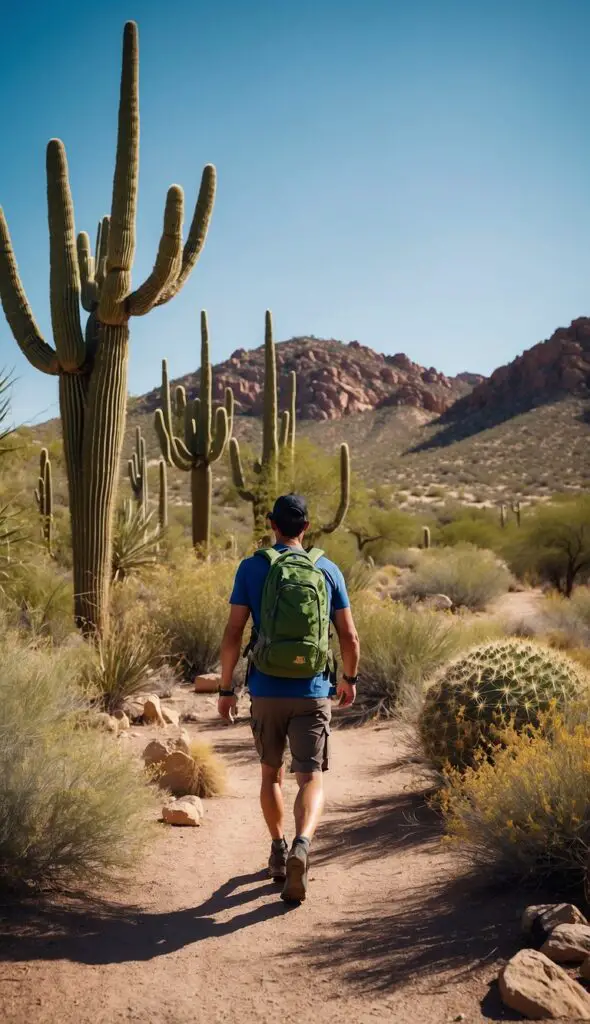Nestled in the heart of the Sonoran Desert, Phoenix, Arizona, beckons adventurers with its rugged beauty and diverse landscapes. As the capital city of Arizona, Phoenix is renowned for its abundance of outdoor activities, with hiking taking center stage amidst its stunning natural backdrop. From towering saguaro cacti to jagged mountain peaks, the city offers an array of trails catering to hikers of all levels, promising exhilarating experiences and breathtaking vistas at every turn.
Surrounded by several notable attractions and parks, Phoenix presents a playground for outdoor enthusiasts seeking more than just hiking. Just a short drive from downtown, Camelback Mountain stands as a prominent landmark, offering challenging trails for seasoned hikers and unparalleled views of the city below. For those craving a closer encounter with desert flora and fauna, the Desert Botanical Garden showcases the region’s rich biodiversity through themed trails and captivating exhibits.
Venture further afield, and you’ll find yourself amidst the rugged beauty of the Tonto National Forest, where endless trails wind through pristine wilderness and ancient saguaro forests. Alternatively, head east to the Superstition Mountains, where the Lost Dutchman State Park entices visitors with its legendary tales and scenic hiking trails, weaving through dramatic canyons and rugged terrain.
While hiking remains a popular pastime in Phoenix, the city offers a myriad of other outdoor activities to complement your adventure. Mountain biking enthusiasts can tackle the challenging trails of South Mountain Park, while rock climbing aficionados can test their skills on the granite cliffs of McDowell Mountains. For a more leisurely experience, consider exploring the city’s expansive network of urban trails, perfect for jogging, cycling, or simply enjoying a scenic stroll amidst desert landscapes. With its abundance of natural wonders and recreational opportunities, Phoenix invites visitors to embrace the great outdoors and embark on unforgettable adventures in the heart of the desert.
Table of Contents
Diverse Terrain
Phoenix, Arizona, is renowned for its diverse terrain, offering a captivating tapestry of landscapes that beckon outdoor enthusiasts to explore its natural wonders. From the iconic saguaro-studded deserts to rugged mountain peaks, the city’s surroundings boast a range of ecosystems that provide endless opportunities for adventure.
At the heart of Phoenix’s landscape lies the Sonoran Desert, a sprawling expanse of arid terrain punctuated by towering saguaro cacti, ocotillo, and prickly pear. Hiking through the desert trails unveils a world of stunning contrasts, where vibrant wildflowers bloom against a backdrop of rugged mountains and expansive desert vistas. Trails like the Gateway Loop in McDowell Sonoran Preserve offer hikers a chance to immerse themselves in the serenity of the desert while marveling at its unique flora and fauna.
Beyond the desert, Phoenix is flanked by rugged mountain ranges that offer a stark contrast to the surrounding lowlands. Camelback Mountain, with its distinctive camel-shaped silhouette, is a popular destination for hikers seeking a challenging ascent and panoramic views of the city below. Piestewa Peak, formerly known as Squaw Peak, provides another iconic hiking experience, with trails winding through rocky terrain and offering sweeping vistas of the surrounding valley.
For those craving a change of scenery, the Tonto National Forest offers a dramatic shift in terrain, with rugged canyons, pine-covered mountains, and pristine lakes waiting to be explored. Trails like the Horton Creek Trail near Payson lead hikers through lush forests and alongside babbling creeks, providing a refreshing escape from the desert heat.
Whether traversing desert trails adorned with towering cacti or scaling rugged mountain peaks, exploring the diverse terrain of Phoenix promises unforgettable outdoor experiences and a deeper appreciation for the natural beauty of the Sonoran Desert.
Iconic Trails
Phoenix, Arizona, boasts an array of iconic trails that showcase the city’s stunning natural beauty and provide hikers with unforgettable outdoor experiences. From rugged mountain peaks to scenic desert landscapes, these trails offer something for adventurers of all levels, promising breathtaking views and thrilling adventures.
Camelback Mountain
Located within the Camelback Mountain Echo Canyon Recreation Area, Camelback Mountain is one of the most recognizable landmarks in the Phoenix area. To reach the trailhead, take Echo Canyon Parkway off of McDonald Drive. The Camelback Summit Trail, also known as the Echo Canyon Trail, is a strenuous 2.5-mile trek that ascends to the mountain’s summit, offering panoramic views of the surrounding valley. The hike typically takes around 2-3 hours round trip. This trail is renowned for its challenging terrain, including steep ascents, rocky scrambles, and narrow ridges. However, the reward is well worth the effort, with unparalleled vistas of Phoenix and the Sonoran Desert awaiting those who reach the summit. Camelback Mountain’s unique rock formations and dramatic scenery make it a must-visit destination for hikers seeking an exhilarating adventure in the heart of the desert.
Piestewa Peak
Situated in the Phoenix Mountain Preserve, Piestewa Peak is another iconic hiking destination in the Phoenix area. To access the trailhead, take Squaw Peak Drive off of Lincoln Drive. The Summit Trail, also known as the Freedom Trail, is a challenging 1.2-mile ascent to the peak’s summit, offering panoramic views of Phoenix and the surrounding mountains. The hike typically takes around 1-2 hours round trip. The trail features steep switchbacks, rocky terrain, and sections of scrambling, providing a rigorous workout for hikers. Despite its difficulty, the breathtaking views from the summit make it a popular destination for outdoor enthusiasts. Piestewa Peak’s close proximity to downtown Phoenix and its stunning vistas make it a favorite among locals and visitors alike.
South Mountain Park
Located in South Mountain Park and Preserve, South Mountain offers a variety of trails suitable for hikers of all levels. To access the park, take Central Avenue south until you reach the main entrance. The park boasts over 50 miles of trails, including the popular Holbert Trail. This moderately difficult trail leads hikers on a 3-mile trek to Dobbins Lookout, where panoramic views of the city and surrounding desert await. The hike typically takes around 2-3 hours round trip. Along the way, hikers will encounter diverse desert flora and fauna, including towering saguaro cacti and desert wildflowers. South Mountain Park’s accessibility, scenic beauty, and diverse trail options make it a must-visit destination for hikers seeking an immersive desert experience.
Lost Dutchman State Park
Located in the Superstition Mountains, Lost Dutchman State Park offers a treasure trove of hiking opportunities amidst stunning desert scenery. To reach the park, take Highway 60 east from Phoenix until you reach the park entrance. The Treasure Loop Trail is a popular choice for hikers, offering a moderate 2.4-mile loop through picturesque desert terrain. The hike typically takes around 1-2 hours round trip. Along the trail, hikers can marvel at towering rock formations, rugged canyons, and panoramic views of the surrounding mountains. The park’s legendary tales of lost gold and its dramatic landscapes make it a captivating destination for hikers and history enthusiasts alike. Whether exploring the iconic trails of Camelback Mountain and Piestewa Peak or venturing further afield to South Mountain Park and Lost Dutchman State Park, hikers in Phoenix are spoiled for choice when it comes to iconic hiking destinations in the desert Southwest.
McDowell Sonoran Preserve
Nestled in the foothills of the McDowell Mountains, the McDowell Sonoran Preserve offers a pristine desert wilderness just minutes from the city center. To access the preserve, take Thompson Peak Parkway north until you reach the trailheads. Among the preserve’s many trails, the Gateway Loop Trail stands out as a favorite among hikers. This moderate 4.5-mile loop meanders through diverse desert landscapes, showcasing saguaro-studded hillsides, rocky outcrops, and expansive views of the surrounding mountains. The hike typically takes around 2-3 hours round trip. With its well-maintained trails and abundant wildlife, including desert bighorn sheep and coyotes, the McDowell Sonoran Preserve provides a tranquil escape for hikers seeking solitude and natural beauty.
Usery Mountain Regional Park
Located in the Usery Mountains, Usery Mountain Regional Park offers a desert oasis with a variety of hiking trails and recreational activities. To reach the park, take Usery Pass Road east from Phoenix until you reach the park entrance. The Wind Cave Trail is a popular choice for hikers, leading to a scenic cave carved into the mountainside. This moderate 1.5-mile trail features switchbacks and rocky terrain, offering panoramic views of the valley below. The hike typically takes around 1-2 hours round trip. At the end of the trail, hikers can explore the cave and enjoy a well-deserved rest in the shade. Usery Mountain Regional Park’s unique geological features and picturesque desert landscapes make it a favorite destination for hikers and nature lovers alike.
Superstition Wilderness Area
Just east of Phoenix lies the rugged and enchanting Superstition Wilderness Area, home to some of the most iconic and challenging hiking trails in the region. Accessible via Highway 60, the area is steeped in legend and lore, with the towering Superstition Mountains serving as a dramatic backdrop. Among the wilderness area’s notable trails, the Siphon Draw Trail stands out as a thrilling adventure for experienced hikers. This strenuous 4.5-mile out-and-back trail leads to the base of the Flatiron, a striking rock formation with sweeping views of the surrounding desert landscape. The hike typically takes around 3-4 hours round trip, with sections of steep inclines and rocky terrain adding to the challenge. Hikers are rewarded with breathtaking vistas and a sense of accomplishment upon reaching the summit, making it a must-visit destination for those seeking an exhilarating wilderness experience.
Phoenix Mountain Preserve
Spanning over 7,000 acres of rugged desert terrain, the Phoenix Mountain Preserve offers a network of trails that wind through picturesque landscapes and offer sweeping views of the city skyline. Accessible from multiple trailheads, including 32nd Street and Lincoln Drive, the preserve is a haven for outdoor enthusiasts seeking adventure close to home. One of the most popular trails in the preserve is the Summit Trail on Piestewa Peak, formerly known as Squaw Peak. This challenging 1.2-mile ascent to the summit rewards hikers with panoramic views of Phoenix and the surrounding mountains. The hike typically takes around 1-2 hours round trip, with steep switchbacks and rocky terrain testing hikers’ endurance. Despite its difficulty, the trail’s stunning vistas and close proximity to downtown Phoenix make it a favorite among locals and visitors alike.
White Tank Mountain Regional Park
West of Phoenix, the White Tank Mountain Regional Park offers a tranquil escape into the desert wilderness, showcasing ancient petroglyphs, rugged canyons, and diverse wildlife. To access the park, take Olive Avenue west until you reach the entrance. The Waterfall Trail is a standout feature of the park, leading hikers on a moderate 1.9-mile round trip journey to a seasonal waterfall nestled within a scenic canyon. The hike typically takes around 1-2 hours round trip, with rocky terrain and occasional stream crossings adding to the adventure. Along the way, hikers can marvel at the petroglyphs etched into the canyon walls, offering a glimpse into the area’s rich cultural history. The serene beauty and cultural significance of the White Tank Mountain Regional Park make it a must-visit destination for hikers seeking a peaceful retreat amidst the desert landscape.
Estrella Mountain Regional Park
Southwest of Phoenix, Estrella Mountain Regional Park offers a diverse range of hiking trails amidst picturesque desert scenery and rolling hills. To reach the park, take Estrella Parkway south until you reach the entrance. The Baseline Trail is a popular choice for hikers, offering a moderate 3.5-mile loop that winds through pristine desert landscapes and offers sweeping views of the Estrella Mountains. The hike typically takes around 2-3 hours round trip, with gentle inclines and well-maintained trails making it suitable for hikers of all levels. Along the way, hikers may encounter desert wildlife such as jackrabbits, quail, and coyotes, adding to the allure of the park’s natural beauty. With its scenic trails and tranquil surroundings, Estrella Mountain Regional Park is a hidden gem for hikers seeking to explore the beauty of the Sonoran Desert.
Cave Creek Regional Park
North of Phoenix, Cave Creek Regional Park offers a rugged desert wilderness with miles of scenic trails and breathtaking vistas. To access the park, take Cave Creek Road north until you reach the entrance. The Go John Trail is a popular choice for hikers, offering a moderate 5.8-mile loop that winds through picturesque desert landscapes and offers stunning views of the surrounding mountains. The hike typically takes around 2-3 hours round trip, with gentle slopes and well-marked trails making it suitable for hikers of all levels. Along the way, hikers can admire towering saguaro cacti, rugged rock formations, and colorful wildflowers, immersing themselves in the beauty of the Sonoran Desert. With its diverse terrain and scenic trails, Cave Creek Regional Park provides a memorable hiking experience for outdoor enthusiasts of all ages.
Wildlife Encounters
In the vast expanse of the Sonoran Desert surrounding Phoenix, wildlife encounters add an extra layer of excitement and wonder to hiking adventures. As hikers traverse the rugged terrain and winding trails, they may find themselves sharing the landscape with a diverse array of desert creatures, each uniquely adapted to thrive in this harsh environment.
One of the most iconic symbols of the desert is the majestic saguaro cactus, which provides shelter and sustenance for a variety of wildlife. Keep an eye out for Gila woodpeckers, whose distinctive drumming can be heard echoing through the desert as they excavate nests in the saguaro’s woody flesh. Meanwhile, the elusive desert tortoise may make an appearance, lumbering slowly across the rocky terrain in search of food.
Birdwatchers will delight in spotting the vibrant plumage of Gambel’s quail as they scurry through the underbrush, or the graceful flight of a red-tailed hawk soaring overhead. In the early morning or evening hours, lucky hikers may even catch a glimpse of a coyote or bobcat stealthily prowling through the desert in search of prey.
For those with a keen eye, the desert floor is alive with a myriad of smaller creatures, from colorful lizards basking in the sun to scorpions scuttling beneath rocks. Patient observers may also be rewarded with sightings of tarantulas, kangaroo rats, and other nocturnal inhabitants emerging under the cover of darkness.
While encountering wildlife in the desert can be a thrilling experience, it’s important for hikers to remember to observe from a respectful distance and refrain from disturbing or feeding wild animals. By respecting the natural rhythms of the desert and allowing wildlife to remain undisturbed in their habitat, hikers can enjoy the magic of these encounters while helping to preserve the delicate balance of life in the Sonoran Desert.
Seasonal Considerations
Seasonal considerations play a crucial role in planning a hiking adventure in Phoenix, Arizona, where the climate can vary dramatically throughout the year. Understanding the unique challenges and opportunities presented by each season is essential for ensuring a safe and enjoyable outdoor experience.
Winter (December-February): Winter in Phoenix brings mild temperatures and clear skies, making it an ideal time for hiking in the desert. Daytime temperatures typically range from the 60s to 70s Fahrenheit, providing comfortable conditions for outdoor activities. However, hikers should be prepared for cooler temperatures in the early morning and evening, as well as the possibility of occasional rain showers. With fewer crowds on the trails, winter offers a peaceful and serene atmosphere for exploring the desert landscape.
Spring (March-May): Springtime in Phoenix brings warmer temperatures and the blooming of desert wildflowers, transforming the landscape into a colorful tapestry of vibrant hues. Daytime temperatures range from the 70s to 80s Fahrenheit, with occasional hot spells as summer approaches. Hikers should be prepared for fluctuating weather conditions, including sudden temperature changes and windy days. Spring is also the peak season for hiking in Phoenix, so trails may be more crowded, especially on weekends and holidays.
Summer (June-August): Summer in Phoenix is characterized by scorching temperatures and intense heat, with daytime highs often exceeding 100 degrees Fahrenheit. Hiking during the summer months can be challenging and potentially dangerous due to the risk of heat-related illnesses such as heat exhaustion and heatstroke. Hikers should take precautions to stay hydrated, avoid hiking during the hottest parts of the day, and wear lightweight, breathable clothing to minimize the risk of overheating. Early morning or evening hikes are recommended to beat the heat and enjoy cooler temperatures.
Fall (September-November): Fall in Phoenix brings relief from the summer heat, with daytime temperatures gradually cooling to more comfortable levels. Daytime highs range from the 80s to 90s Fahrenheit, making it an ideal time for outdoor activities. Fall also marks the beginning of the desert hiking season, as temperatures become more conducive to hiking and exploring the wilderness. Hikers can expect clear skies and pleasant weather conditions, although occasional rain showers are possible as the desert transitions into the cooler months.
Overall, each season offers its own unique rewards and challenges for hikers in Phoenix. By planning accordingly and taking seasonal considerations into account, outdoor enthusiasts can make the most of their hiking adventures and enjoy the beauty of the Sonoran Desert year-round.
Safety Tips
When embarking on a hiking adventure in Phoenix, Arizona, safety should always be a top priority to ensure a memorable and enjoyable experience in the desert landscape. Here are some essential safety tips to keep in mind before hitting the trails:
1. Hydration is Key: The desert climate in Phoenix can be unforgiving, especially during the hot summer months. It’s crucial to stay hydrated by drinking plenty of water before, during, and after your hike. Bring an adequate supply of water, and consider using a hydration pack or water bottles with built-in filters for longer treks.
2. Dress Appropriately: Wear lightweight, breathable clothing that provides protection from the sun, such as long-sleeved shirts, pants, and wide-brimmed hats. Opt for moisture-wicking fabrics to help keep you cool and comfortable, and don’t forget to apply sunscreen with a high SPF rating to exposed skin.
3. Know Your Limits: Choose hiking trails that match your fitness level and experience. Start with shorter, easier trails if you’re a beginner or unfamiliar with the desert environment. Be honest with yourself about your physical abilities and don’t push yourself beyond your limits.
4. Stay on Marked Trails: Stick to designated hiking trails and avoid venturing off-trail to minimize the risk of getting lost or encountering hazardous terrain. Pay attention to trail markers and signage, and always carry a map or GPS device to help navigate unfamiliar areas.
5. Be Prepared for Wildlife Encounters: While encounters with wildlife are rare, it’s essential to be aware of your surroundings and know how to react if you encounter desert wildlife. Keep a safe distance from animals, never feed or approach them, and familiarize yourself with basic wildlife safety protocols.
6. Check the Weather Forecast: Before heading out on a hike, check the weather forecast to prepare for any potential changes in weather conditions. Avoid hiking during extreme heat or inclement weather, and be prepared to adjust your plans accordingly if conditions worsen.
7. Let Someone Know Your Plans: Before starting your hike, inform a friend or family member of your intended route and expected return time. Consider sharing your itinerary with them, including details such as the trail you’ll be hiking, estimated duration, and emergency contact information.
8. Carry Essential Supplies: Pack a basic hiking kit with essential supplies such as a first-aid kit, flashlight or headlamp with extra batteries, multi-tool or knife, whistle, and emergency shelter. Additionally, bring snacks high in protein and energy to fuel your hike.
By following these safety tips and exercising caution while hiking in Phoenix, you can enjoy the beauty of the Sonoran Desert while minimizing the risks associated with outdoor adventures. Remember to always prioritize safety and be prepared for whatever the desert landscape may have in store.
Leave No Trace
Practicing Leave No Trace principles is essential for preserving the natural beauty and ecological integrity of the hiking trails in Phoenix, Arizona. By minimizing our impact on the environment, we can ensure that these pristine landscapes remain accessible and enjoyable for future generations of outdoor enthusiasts. Here are some key Leave No Trace principles to keep in mind while hiking in Phoenix:
1. Plan Ahead and Prepare: Before heading out on your hike, take the time to research the trail you’ll be exploring and familiarize yourself with the rules and regulations of the area. Pack all necessary supplies, including water, food, and emergency equipment, and plan your route to minimize your impact on sensitive habitats.
2. Travel and Camp on Durable Surfaces: Stick to designated trails and campsites to avoid trampling fragile vegetation and damaging sensitive habitats. When setting up camp, choose a durable surface such as rock, gravel, or sand, and avoid disturbing vegetation or wildlife.
3. Dispose of Waste Properly: Pack out all trash and waste, including food wrappers, toilet paper, and human waste. Bring a sealable bag to store your trash and carry it out with you, leaving the trail cleaner than you found it. If necessary, bury human waste in a cat hole at least 6-8 inches deep and 200 feet away from water sources.
4. Leave What You Find: Resist the temptation to take souvenirs from the trail, such as rocks, plants, or wildlife. Leave natural objects and cultural artifacts undisturbed for others to enjoy, and take only photographs and memories with you when you leave.
5. Minimize Campfire Impacts: Observe fire regulations and restrictions in the area, and use a lightweight camp stove for cooking instead of building a campfire. If you do build a campfire, use existing fire rings whenever possible, and make sure to fully extinguish the fire before leaving your campsite.
6. Respect Wildlife: Observe wildlife from a safe distance and avoid approaching or feeding animals. Keep your pets on a leash at all times and prevent them from disturbing wildlife or other hikers. Remember that we are guests in the animals’ natural habitat and should act accordingly.
7. Be Considerate of Other Visitors: Be courteous to other hikers and trail users by yielding the right of way, keeping noise levels to a minimum, and respecting their privacy and solitude. Practice proper trail etiquette and avoid overcrowding popular trails during peak times.
By following these Leave No Trace principles, we can help protect the natural environment and ensure that future generations can continue to enjoy the beauty and serenity of the hiking trails in Phoenix, Arizona. Together, we can make a positive impact and preserve these treasured landscapes for years to come.
Community Resources
When planning a hiking adventure in Phoenix, Arizona, there are numerous community resources available to help ensure a safe and enjoyable experience on the trails. From trail maps and guided tours to visitor centers and online forums, these resources offer valuable information and support for hikers of all levels. Here are some essential community resources to help you make the most of your hiking experience in Phoenix:
1. Phoenix Parks and Recreation Department: The Phoenix Parks and Recreation Department manages a vast network of parks and trails throughout the city, including popular hiking destinations such as Camelback Mountain and South Mountain Park. Their website provides information on trail conditions, park amenities, and upcoming events, making it a valuable resource for planning your hiking adventures. Phoenix Parks and Recreation Department
2. McDowell Sonoran Conservancy: The McDowell Sonoran Conservancy is dedicated to preserving and protecting the McDowell Sonoran Preserve, one of the largest urban preserves in the country. Their website offers trail maps, educational resources, and volunteer opportunities for those interested in learning more about the desert ecosystem and helping to maintain the trails. McDowell Sonoran Conservancy
3. Arizona Hiking Shack: Located in Phoenix, the Arizona Hiking Shack is a local outdoor retailer specializing in hiking and camping gear. In addition to selling equipment and apparel, they also offer guided hikes, gear rentals, and outdoor education classes to help hikers prepare for their adventures in the desert. Arizona Hiking Shack
4. Arizona Trail Association: The Arizona Trail Association is a nonprofit organization dedicated to maintaining and promoting the Arizona National Scenic Trail, which spans over 800 miles from Mexico to Utah. Their website provides information on trail segments, volunteer opportunities, and events, as well as resources for planning thru-hikes and backpacking trips. Arizona Trail Association
5. Phoenix Outdoor Enthusiasts: For those looking to connect with fellow outdoor enthusiasts and find hiking partners, the Phoenix Outdoor Enthusiasts meetup group offers a variety of group hikes and outdoor activities. Their online platform allows members to join upcoming hikes, share trail recommendations, and connect with like-minded individuals who share a passion for exploring the great outdoors. Phoenix Outdoor Enthusiasts
By utilizing these community resources, hikers can access valuable information, connect with local experts, and find support and camaraderie within the outdoor community. Whether you’re a seasoned trekker or a first-time hiker, these resources can help you make the most of your hiking adventures in Phoenix, Arizona.
Conclusion
In conclusion, hiking in Phoenix, Arizona, offers a gateway to unparalleled natural beauty and outdoor adventure in the heart of the Sonoran Desert. From iconic peaks to serene desert trails, the city’s diverse landscape provides endless opportunities for exploration and discovery. Whether you’re marveling at towering saguaro cacti, soaking in panoramic views from mountain summits, or encountering wildlife in its natural habitat, every hike in Phoenix promises a memorable experience that connects you with the awe-inspiring beauty of the desert Southwest.
As you lace up your hiking boots and hit the trails, remember to respect the fragile ecosystems and cultural heritage of the desert landscape by practicing Leave No Trace principles and following safety guidelines. By embracing the spirit of adventure while also prioritizing conservation and stewardship, we can ensure that future generations can continue to enjoy the natural wonders of Phoenix’s hiking trails for years to come. So, whether you’re seeking a challenging ascent, a leisurely stroll, or simply a moment of serenity amidst the desert wilderness, let Phoenix be your playground and embark on a hiking adventure that will leave you with lasting memories and a deeper appreciation for the wonders of the natural world.







